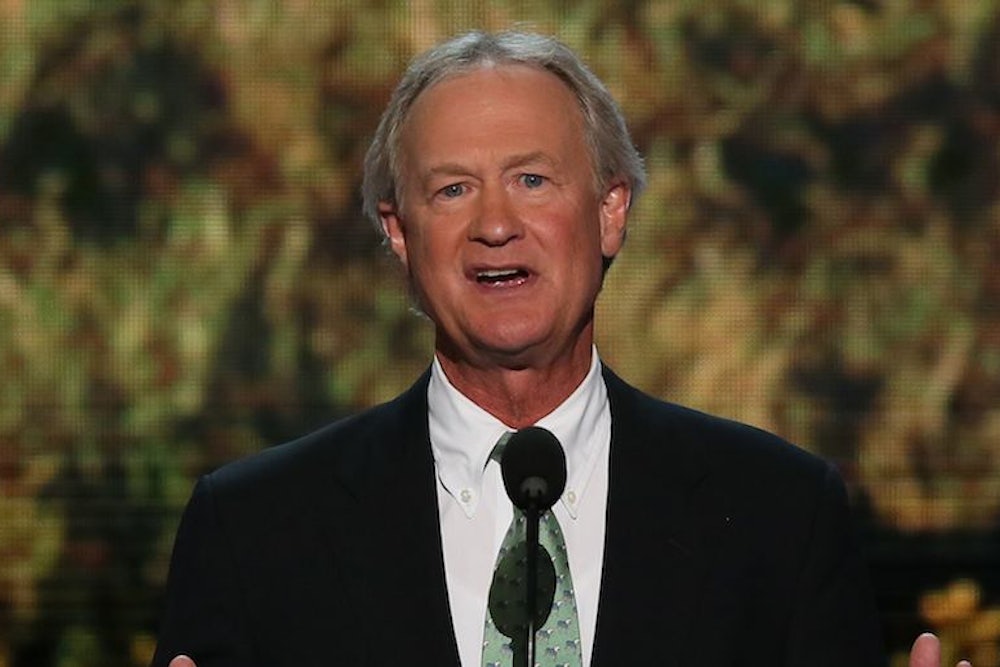Rhode Island's Lincoln Chafee could very well be the least popular governor in the country—by a wide margin, according to Nate Silver at The New York Times. Just three years after a political comeback as an independent candidate (he was a liberal Republican until he lost his Senate seat in 2006), the state's economy is bad enough that Chafee’s approval ratings have fallen into the twenties. This week, perhaps in desperation, he announced he's switched parties again: Now he’s a Democrat, setting up one of the most interesting contests of 2014.
Chafee’s move left makes some sense. He eked out a victory in 2010 by winning a majority of the state’s Democratic coalition and carrying most of the state’s Democratic strongholds. In 2014, it would be tough for an independent Chafee to reclaiming a majority of Rhode Island’s Democratic coalition. Chafee’s approval ratings among Democrats are mired in the mid-forties, and Democrats were poised to nominate one of two popular candidates—State Treasurer Gina Raimondo or Providence Mayor Angel Taveras—who could have capitalized on Chafee’s lackluster economic record.
The calculus is straightforward. To start with, winning the primary might not be more difficult for Chafee than winning the general. A PPP survey conducted in late January showed that Chafee’s approval ratings were strongest among Democrats, so it might even be easier to win a primary than the general. And a three-way primary might make it easier to skate by with a plurality, and then consolidate the Democratic coalition in the general election without another Democrat nibbling away at his base.
That calculation might make even more sense after considering the political strengths and weaknesses of Raimondo, the favorite for the Democratic nomination and a formidable candidate. The 42-year-old treasurer received national acclaim for her pension reform program, and she’s a former venture capitalist with degrees from Harvard, Yale, and Oxford, where she was a Rhodes Scholar. She’s also an impressive campaigner who holds a solid 57-21 favorability rating. If you ask me or my colleague Alec MacGillis, it’s not preposterous to say she's a plausible 2024 presidential candidate.
Had Chafee remained an independent and Raimondo won the Democratic nomination, he would have been in a tough spot in the general election. Raimondo is popular enough to do well among Democrats, but she also has very impressive ratings among Republicans (52-23) and independents (63-19)—exactly the type of voters that Chafee, a former Republican and now former independent, should be able to count on against a Democratic challenger. To wit, PPP showed Raimondo leading Chafee by 10 points in a hypothetical general election contest, with Chafee actually in third place.
But the Democratic primary is a different story altogether. Raimondo is no shoo-in for the nomination, as she has a weak left flank: Her pension reform plan hasn’t endeared her to the state’s liberal Democrats. That explains why her 53 percent favorability rating among Democrats is only one point better than her 52 percent rating among Republicans. On the other hand, it’s unclear how Chafee could exploit Raimondo’s weakness. After all, he supported Raimondo’s pension reform plan and he wasn’t even a Democrat until this week.
One might guess that the beneficiary of all this is Taveras, Providence's union-backed mayor. He was already well-positioned to challenge Raimondo from the left, in what National Journal billed as a “larger preview of which forces hold more sway in the Democratic Party.” Earlier this year, PPP showed Raimondo leading Taveras by a healthy but hardly insurmountable 9-point margin, 44-35. Taveras actually held a 2-point lead among Democrats, but that slim margin was swamped by Raimondo’s 23-point advantage among independents, who are eligible to participate in Rhode Island’s open Democratic primary. If Chafee could cut into Raimondo’s standing among the affluent, fiscally moderate voters who appear to make up her base, her 9-point lead over Taveras could narrow quickly.
And yet, PPP's January poll showed Chafee drawing more supporters from Taveras than Raimondo. PPP even exhibited some foresight by asking Democratic primary voters how they would vote if Chafee ran as a Democrat, and they found him trailing Raimondo by 13 points, 35 to 22 percent, with Taveras in third place at 19 percent. On paper, there’s not a great explanation for Chafee’s strength on the left. That said, there are a few reasons why Chafee might have earned loyalty from Democratic activists: his skepticism of education reform, or prominent support for President Barack Obama or gay marriage. But even if PPP is right and Chafee is indeed positioned to challenge Raimondo from the left, he still might not be considered the favorite if he’s splitting the left wing with Taveras.
It’s possible that Chafee’s switch might earn him enough additional support among Democrats and liberals to win re-election. But Chafee’s weak numbers among independents in January, when he really was an independent, also suggests that his problems with Democrats weren't simply that he wasn't a Democrat; rather, voters just don’t have much confidence in the direction of the state. And so, as long as Rhode Island’s many voters continue to harbor an unfavorable view of his performance, he probably won’t build the support necessary to win a statewide contest. No matter his party, he's likely to lose.
